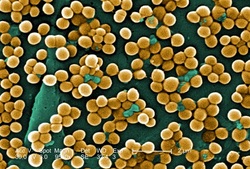Biological Properties

The yellow clusters of Staphylococcus aureus.
Staphylococcus aureus is a spherical bacterium with a diameter of one micrometer. It occurs in grapelike clusters when microscopically examined. The clusters are very large, 6-8 mm in diameter.
Staphylococcus aureus is translucent and is smooth on its surface.
Staphylococcus aureus contains the carotenoid pigment, staphyloxanthin, which produces its yellow color. The yellow pigment actually protects the bacteria from fatal attacks by the human immune system through its antioxidant properties.
Staphylococcus aureus is an anaerobic bacterium facultatively but grows by aerobic respiration or fermentation.
Staphylococcus aureus reproduces through asexual reproduction. When the DNA is reproduced, the new cell wall does not fully separate from the existing wall, and so the cells exist in clusters.
Staphylococcus aureus frequently lives in the nose and on the skin of healthy humans without causing infection or disease.
Staphylococcus aureus has the following properties:
· Cocci
· Yellow clusters of spherical bacterium
· Non-spore forming
· Facultatively anaerobic
· Gram-positive
· Coagulase-positive (clot formation ability)
· Catalase-positive (conversion of hydrogen peroxide to water and oxygen)
Fact: About 25% of the human population are everyday carriers of Staphylococcus aureus on the skin and in the nasal passages.
Staphylococcus aureus is translucent and is smooth on its surface.
Staphylococcus aureus contains the carotenoid pigment, staphyloxanthin, which produces its yellow color. The yellow pigment actually protects the bacteria from fatal attacks by the human immune system through its antioxidant properties.
Staphylococcus aureus is an anaerobic bacterium facultatively but grows by aerobic respiration or fermentation.
Staphylococcus aureus reproduces through asexual reproduction. When the DNA is reproduced, the new cell wall does not fully separate from the existing wall, and so the cells exist in clusters.
Staphylococcus aureus frequently lives in the nose and on the skin of healthy humans without causing infection or disease.
Staphylococcus aureus has the following properties:
· Cocci
· Yellow clusters of spherical bacterium
· Non-spore forming
· Facultatively anaerobic
· Gram-positive
· Coagulase-positive (clot formation ability)
· Catalase-positive (conversion of hydrogen peroxide to water and oxygen)
Fact: About 25% of the human population are everyday carriers of Staphylococcus aureus on the skin and in the nasal passages.
